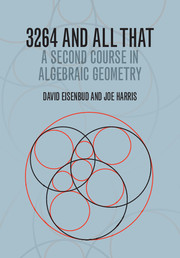Book contents
- Frontmatter
- Contents
- Preface
- Chapter 0 Introduction
- Chapter 1 Introducing the Chow ring
- Chapter 2 First examples
- Chapter 3 Introduction to Grassmannians and lines in ℙ3
- Chapter 4 Grassmannians in general
- Chapter 5 Chern classes
- Chapter 6 Lines on hypersurfaces
- Chapter 7 Singular elements of linear series
- Chapter 8 Compactifying parameter spaces
- Chapter 9 Projective bundles and their Chow rings
- Chapter 10 Segre classes and varieties of linear spaces
- Chapter 11 Contact problems
- Chapter 12 Porteous' formula
- Chapter 13 Excess intersections and the Chow ring of a blow-up
- Chapter 14 The Grothendieck Riemann–Roch theorem
- Appendix A The moving lemma
- Appendix B Direct images, cohomology and base change
- Appendix C Topology of algebraic varieties
- Appendix D Maps from curves to projective space
- References
- Index
Chapter 3 - Introduction to Grassmannians and lines in ℙ3
Published online by Cambridge University Press: 05 March 2016
- Frontmatter
- Contents
- Preface
- Chapter 0 Introduction
- Chapter 1 Introducing the Chow ring
- Chapter 2 First examples
- Chapter 3 Introduction to Grassmannians and lines in ℙ3
- Chapter 4 Grassmannians in general
- Chapter 5 Chern classes
- Chapter 6 Lines on hypersurfaces
- Chapter 7 Singular elements of linear series
- Chapter 8 Compactifying parameter spaces
- Chapter 9 Projective bundles and their Chow rings
- Chapter 10 Segre classes and varieties of linear spaces
- Chapter 11 Contact problems
- Chapter 12 Porteous' formula
- Chapter 13 Excess intersections and the Chow ring of a blow-up
- Chapter 14 The Grothendieck Riemann–Roch theorem
- Appendix A The moving lemma
- Appendix B Direct images, cohomology and base change
- Appendix C Topology of algebraic varieties
- Appendix D Maps from curves to projective space
- References
- Index
Summary
Keynote Questions
(a) Given four general lines L1,…, L4 ⊂ ℙ3, how many lines L ⊂ ℙ3 will meet all four? (Answer on page 110.)
(b) Given four curves C1,…, C4 ⊂ ℙ3 of degrees d1,…, d4, how many lines will meet general translates of all four? (Answer on page 112.)
(c) If C, C′ ⊂ ℙ3 are two general twisted cubic curves, how many chords do they have in common? That is, how many lines will meet each twice? (Answer on page 115.)
(d) If Q1,…, Q4 ⊂ ℙ3 are four general quadric surfaces, how many lines are tangent to all four? (Answer on page 125.)
Enumerative formulas
In this chapter we introduce Grassmannian varieties through enumerative problems, of which the keynote questions above are examples. To clarify this context we begin by discussing enumerative problems in general and their relation to the intersection theory described in the preceding chapters.
In Section 3.2 we lay out the basic facts about Grassmannians in general. (Sections 3.2.5 and 3.2.6 may be omitted on the first reading, but will be important in later chapters.)
Starting in Section 3.3 we focus on the Grassmannian of lines in ℙ3. We calculate the Chow ring and then, in Sections 3.4 and 3.6, use this to solve some enumerative problems involving lines, curves and surfaces in ℙ3. In Section 3.5 we introduce the key technique of specialization, using it to re-derive some of these formulas.
What are enumerative problems, and how do we solve them?
Enumerative problems in algebraic geometry ask us to describe the set Φ of objects of a certain type satisfying a number of conditions—for example, the set of lines in ℙ3 meeting each of four given lines, as in Keynote Question (a), or meeting each of four given curves Ci ⊂ ℙ3, as in Keynote Question (b). In the most common situation, we expect Φ to be finite and we ask for its cardinality, whence the name enumerative geometry. Enumerative problems are interesting in their own right, but—as van der Waerden is quoted as saying in the introduction—they are also a wonderful way to learn some of the more advanced ideas and techniques of algebraic geometry, which is why they play such a central role in this text.
- Type
- Chapter
- Information
- 3264 and All ThatA Second Course in Algebraic Geometry, pp. 85 - 130Publisher: Cambridge University PressPrint publication year: 2016

